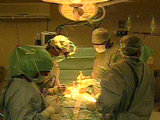|
Dr. Jaap Bonjer, Head of the Department of Surgery, �鶹��ý, and Chief of Surgery, Capital District Health Authority, presented the report, along with the Honourable Chris d'Entremont, Minister of Health, and Bruce Quigley, CEO of Cumberland Health Authority. The data reported on was collected between December 2006 and July 2007.
During his presentation, Dr. Bonjer noted, "This report was prepared in the spirit of great optimism. The hope is to inject a fresh vision, a clear plan and focused energy into the way we work together to provide timely, high quality surgical services to the residents of Nova Scotia and Atlantic Canada."
The report offers a broad range of options for consideration and action to address surgical wait times.��Highlights include: taking a system-wide approach; making the most of current facilities; addressing the nursing shortage; putting the patient at the centre of care; and managing demand.
��
Minister d'Entremont welcomed the work of �鶹��ý’s Department of Surgery. "You need to know and understand the complexities of the wait list before you can begin reducing it. This is a terrific beginning to improve access." He also echoed the theme of collaboration evident in the report. "As we are all learning, addressing wait times requires many committed partners working together ... hospitals, doctors, government, patients and their families. Tackling this issue requires action and input from clinicians who are closest to the patients and truly understand the challenges. This kind of innovative approach is exactly what we need."
��
One of the innovations promoted in the report is around choice for patients on when and where they can receive surgical services. Mr. Quigley spoke to one pilot currently underway between Cumberland Health Authority and Capital Health.
"We are a relatively small province with limited resources and this type of innovative "systems-thinking" program makes available the best possible care in the most immediate time frame," said Mr. Quigley. "Patients from Capital Health requiring hernia repair surgery now have the choice of accessing quality health care in Cumberland County where the wait times are much shorter than in the metro area," he added.
��
Dr. Bonjer finished his presentation emphasizing the three themes evident in the report. “Think like a system. Work like a team. And believe that anything is possible when it comes to taking care of our patients."
SEE:

 ����
����